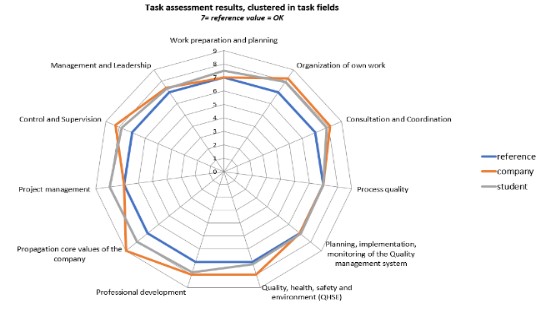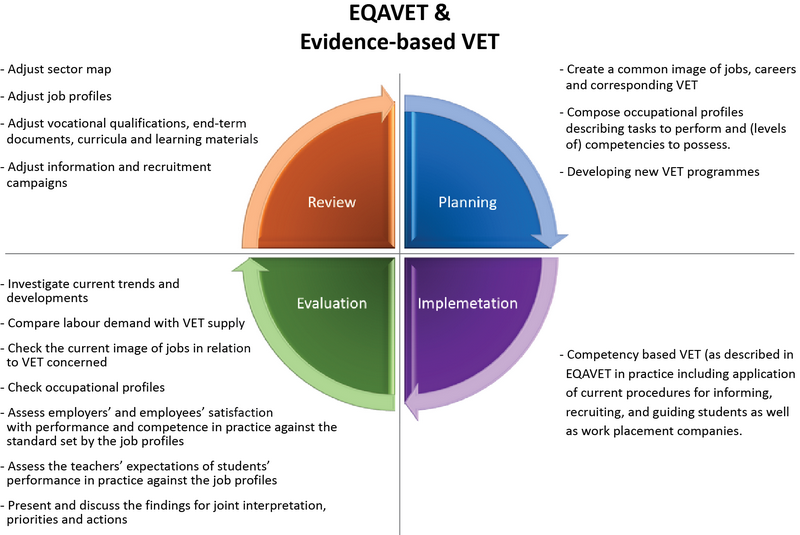The approach applied in the QSE project is based on its partners’ presumption that there is and there always will be some distance between labour demands and VET supply in terms of quantity and quality. The challenging assignment for stakeholders on both sides is to be aware of this friction between them and to keep the inescapable gaps as narrow as possible.
The project started with national investigations among stakeholders in the four countries to explore and raise the awareness of the challenge implied by the Eqavet indicators 5 and 6; How to deal with these challenges?
This yielded various priorities for a establishing a better and sustainable match of VET supply with evolving labour demands. The project chose to focus on a stronger collaboration of stakeholders, supported by a structural approach, a common frame of reference as well as a common vocabulary
These issues have been worked out in four practical national experiments centred around the most common professions at EQF level 2-5 in three different sectors to find out
- to what extent VET programs proved to be relevant in terms of quantity and quality for the jobs concerned.
- to determine the added value of the approach and tools applied.
The UK and Greece worked with kitchen staff occupations, Italy chose regional banking branch staff and Sweden focused on electricians in housing and utility building.
|
EQF level |
UK/Greece Kitchen staff |
Italy Local bank staff |
Sweden Electrical engineering |
|
5 |
Head chef |
Area branch coordinator |
- |
|
4 |
Branch manager |
Senior/leading electrician Electrician Junior electrician |
|
|
3 |
Cook/Chef de partie |
Vice branch manager |
|
|
2 |
Kitchen porter |
|
The present guidelines are based on the good experiences gained in these experiments. They confirm the initial priorities and lead to the next recommendations at different levels for the various stakeholders concerned.
- At National level
- Address and support social partners at sector level regarding a clear articulation of their labour demands for the short and long term. Give them the lead in defining job requirements as a basis for qualifications
- Create and support an (institutional) infrastructure with clear instructions, guidelines and formats for joint translation of job requirements and developments towards qualifications and targets by VET and labour representatives
- Conduct frequent research to generate adequate information to facilitate VET programmers and policymakers concerned.
- Create balance in responsibilities and control of VET and labour representatives in policies and programs.
- At (national) sector level
- Be as clear, specific, honest and up-to-date as possible on labour demands, job requirements and career perspectives.
- Create a network of companies committed to professional education to discuss educational issues and represent the sector.
- Take initiative in setting the standards for craftsmanship and the dialogue with VET providers on qualifications, curricula and learning materials.
- At Regional level (of VET providers and companies)
- Make active use of job profiles as applied in the QSE project to support work placements and companies’ assessments and evaluations.
- Make sure end term documents and curricula relate to and correspond with tasks to be performed, (work) results to be achieved and abilities to possess.
- Pay attention to innovation as a separate subject in curricula, (work placement) assignments and learning materials (independent of qualifications yet to be adjusted to new regulations, technologies etc.).
The guidelines follow the line of activities in the national experiments. Each chapter zooms in on one of the next subjects:
- Designing a sector map: “An image is worth a 1.000 words”
Modern VET programs train for more than one job. Students (and their parents) expect future career prospects to be evident. Sectors are challenged to present themselves as an attractive and varied work environment and to put the jobs which VET programmes train for in a wider perspective.
Given the sectoral orientation of the project and living in todays’ visual world, the partners opted for a visual display of the sectors’ occupations; a “sector map” to present jobs and careers in their own context.
Such a practical visual representation of the sectoral professional domain offers a background for a basic match with VET supply and a canvas to present statistical information like numbers of workers, vacancies and surpluses . The first chapter of the guidelines explains why and how to make and use such a sector map yourself. - Composing job profiles
Sectors are only entitled to criticise the quality of education if they have made it clear which criteria it should meet. The project therefore focussed on assisting sectors to compose a common standard for their jobs’ content in terms of tasks to perform and abilities to possess. The job profiles composed turned out to be highly appreciated by the companies not only as a clear and specific common job description but also suitable for job appraisal interviews and career planning.
The second chapter of the guidelines shows you how to compose similar job profiles, including the “ready-to-use” examples from jobs concerned in the project.
- Establishing quantities
Relevant data turned out difficult to find and access. As far as statistical data were available, they often lacked the level of detail required to match the (regional) demand and supply per occupation and its corresponding VET program(s). Without being able to quantify the gaps however, it became evident there are (growing) shortages in all jobs of two out of the three sectors and three out of four countries involved.
Determining numbers, establishing shortages and surpluses in supply and demand seems a matter of "catch as catch can" The third chapter guides you through the questions you can ask yourself in order to obtain the best possible picture of the relationship between vacancies and the outflow of graduates. - Assessing quality: “The proof of the training is in the performance”
The job profiles composed were converted into assessment forms and supplemented with questionnaires for employers and their “fresh employees” to establish their satisfaction with tasks performed and abilities proved in practice. Similar forms were drawn up for VET schools to classify their programs against the job requirement standards set by the companies.
The job profiles proved to be a well-recognized touchstone for craftsmanship. In general, the VET programmes turned out to be very relevant, with a few minor but interesting exceptions as illustrated by the spider graphs based on the response.
The fourth chapter shows how you -in this same manner- can determine whether and to what extent your students and their employers are satisfied with the result of your VET programmes.
QUALITY ENHANCEMENT & ASSURANCE
- Organizing dialogue
All the information and “evidence” thus created and collected is to be presented as nutritious food for the dialogue to conduct. The fifth chapter presents the preconditions for a fruitful dialogue and offers suggestions for issues to address and the questions for partners to discuss with special attention for the concept of “focus groups”
- Assuring relevance
The sixth chapter explores how the EQAVET quality cycle can be used by stakeholder collaborations committed to addressing proven or imminent mismatches. The image below shows how the various activities and instruments described in the guideline above fit into such a quality circle to develop and maintain an optimal match between VET supply and labour demand in quantity and quality.

The guidelines address various organizations involved at different levels. The tools can be applied accordingly. This mainly depends on the current national arrangements made and parties concerned in your own country. It will also depend on your own position, possibilities and ambitions.
The main actors at national level will be:
- VET authorities like the ministry of education and its agencies responsible for the national VET infrastructure and policies.
- VET representatives like National schools’ federations, often mirroring the economic sectors.
- “Organized businesses” Sector organizations or employers’ associations representing a group of similar companies sharing a specific market not only in terms of products and clients but also in terms of labour and VET demand.
- Trade unions, and professional associations
At this level it will mainly concern development and maintenance of national qualifications and/or end-term documents, National information and recruitment campaigns (for students as well as work placement companies, etc.
At regional level the subjects will address:
- Big regional VET providers or groups of local colleges.
- Regional divisions of sector organizations
- Bigger regional companies
- Regional and local (VET) authorities.
At this level it will likely concern the elaboration of the curriculum and typical regional circumstances requiring elaboration or adaption as far as allowed within national arrangements to fit specific regional needs. This may concern recruitment of work placement companies, guest teachers, sponsoring technical facilities, etc.
The guidelines can be seen as a “road map” suggesting a logical route to follow by taking consecutive steps from start to end and then repeat the process in a continuous loop. The guidelines and the tools they recommend can also been seen as a “menu” with instructions and examples to choose from, depending on your own position, interests and priorities.
You can start using the guidelines to evaluate and review existing VET programmes or for a complete development and evaluation cycle of a new VET programme. The choice is yours!
The guidelines do not cover the implementation phase since this has already been developed by the toolkit developed in “EQAVET in Practice”, please see https://www.eqavet.eu/Top-Navigation/EQAVETinPractice
You can make a choice by clicking the menu below to go to your first subject or navigate through the guidelines with the index to the left of the screen.With the purple button at the right bottom corner of the screen you can go back up to the top of the chapter.With the arrows at the end of each chapter or paragraph you can go to the previous or next chapter.





